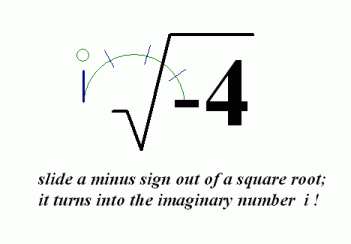 The Square Root of a Negative Number
The Square Root of a Negative Number
Square roots of negative numbers were introduced in a prior lesson: Arithmetic with Complex Numbers in the Algebra II materials. For your convenience, that material is repeated (and extended) here.
Firstly, recall some information from beginning algebra:
The Square Root of a Nonnegative Real Number
For a nonnegative real number $\,k\,,$
$ \cssId{s7}{\overbrace{\ \ \ \sqrt{k}\ \ \ }^{\text{the square root of $\,k\,$}}} $ equals, by definition, the unique nonnegative real number which, when squared, equals $\,k\,.$
(Note: When the distinction becomes important in higher-level mathematics, then $\,\sqrt{k}\,$ is called the principal square root of $\,k\,.$ )
Thus, the number that gets to be called the square root of $\,k\,$ satisfies two properties:
- it is nonnegative (not negative; i.e., greater than or equal to zero)
- when squared, it gives $\,k\,$
For example, $\,\sqrt{9} = 3\,$ since the number $\,3\,$ satisfies these two properties:
- $\,3\,$ is nonnegative
- $\,3\,,$ when squared, gives $\,9\,$: $\,3^2 = 9$
So, what is (say) $\,\sqrt{-4}\ $? There does not exist a nonnegative real number which, when squared, equals $\,-4\ .$ Why not? Every real number, when squared, is nonnegative: for all real numbers $\,x\,,$ $\,x^2 \ge 0\,.$ Complex numbers to the rescue!
The Square Root of a Negative Number
Complex numbers allow us to compute the square root of negative numbers, like $\,\sqrt{-4}\,.$ Remember the key fact: $\,i:=\sqrt{-1}\,,$ so that $\,i^2=-1\,.$
Let $\,p\,$ be a positive real number, so that $\,-p\,$ is a negative real number. Then:
$$ \cssId{s31}{\overbrace{\ \ \ \sqrt{-p}\ \ \ }^{\text{the square root of negative $\,p\,$}}} \ \cssId{s32}{:=}\ \cssId{s33}{i\,\sqrt{\vphantom{h}p}} $$(Note: When the distinction becomes important in higher-level mathematics, then $\,\sqrt{-p}\,$ is called the principal square root of $\,-p\,.$ )
Observe that $\,i\sqrt{\vphantom{h}p}\,,$ when squared, does indeed give $\,-p\,$:
$$ \begin{align} \cssId{s36}{(i\sqrt{\vphantom{h}p})^2} \ &\cssId{s37}{=\ i^2(\sqrt{\vphantom{h}p})^2}\cr\cr &\cssId{s38}{=\ (-1)(p)}\cr\cr &\cssId{s39}{=\ -p} \end{align} $$Some of my students like to think of it this way: You can slide a minus sign out of a square root, and in the process, it turns into the imaginary number $\,i\,$!

Examples
Here are some examples:
-
$\sqrt{-4} = i\sqrt{4} = i2 = 2i\,$
It is conventional to write $\,2i\,,$ not $\,i2\,.$ When there's no possible misinterpretation (see below), write a real number multiplier before the $\,i\,.$
-
$\sqrt{-5} = i\sqrt{5}$
In this situation, it's actually better to leave the $\,\sqrt{5}\,$ after the $\,i\,.$
Why? If you pull the $\,\sqrt{5}\,$ to the front, it can lead to a misinterpretation, as follows:
The numbers $\,\sqrt{5}i\,$ and $\,\sqrt{5i}\,$ are different numbers—look carefully! In $\ \sqrt{5}i\ $, the $\,i\,$ is outside the square root. In $\ \sqrt{5i}\ $, the $\,i\,$ is inside the square root. Unless you look carefully, however, you might mistake one of these for the other. By writing $\,i\sqrt{5}\,,$ you eliminate any possible confusion.
Two Different Questions; Two Different Answers
Recall these two different questions, with two different answers:
-
What is $\,\sqrt{4}\,$?
Answer: By definition, $\,\sqrt{4} = 2\,.$ The number $\ \sqrt{4}\ $ is the nonnegative number which, when squared, gives $\,4\,.$
-
What are the solutions to the equation $\,x^2 = 4\,$?
Answer: $\,x= \pm\ 2\,.$ There are two different real numbers which, when squared, give $\,4\,.$
Similarly, there are two different questions involving complex numbers, with two different answers:
-
What is $\,\sqrt{-4}\,$?
Answer: $\sqrt{-4} = 2i\,$
-
What are the (complex) solutions to the equation $\,x^2 = -4\,$?
Answer: $\,x=\pm \sqrt{-4} = \pm\ 2i\,.$ There are two different complex numbers which, when squared, give $\,-4\,.$
Verifying the second solution:
$$ \cssId{s74}{(-2i)(-2i)} \cssId{s75}{= 4i^2} \cssId{s76}{= 4(-1)} \cssId{s77}{= -4} $$
Square Roots of Products
The following statement is true: for all nonnegative real numbers $\,a\,$ and $\,b\,,$ $\,\sqrt{ab} = \sqrt{a}\sqrt{b}\ $. For nonnegative numbers, the square root of a product is the product of the square roots.
Does this property work for negative numbers, too? The answer is no, as shown next.
Certainly, anything called ‘the square root of $\,-4\,$’ must have the property that, when squared, it equals $\,-4\ .$ Unfortunately, the following incorrect reasoning gives the square as $\,4\,,$ not $\,-4\,$:
$$ \begin{align} &\cssId{s87}{\text{? ? ? ? }} \cssId{s88}{(\sqrt{-4})^2}\cr\cr &\qquad\ \cssId{s89}{=\ \ \sqrt{-4}\sqrt{-4}}\cr\cr &\cssId{s90}{\overbrace{\ \ =\ \ }^{\text{this is the mistake}}} \cssId{s91}{\sqrt{(-4)(-4)}}\cr\cr &\qquad\ \cssId{s92}{=\ \ \sqrt{16}}\cr\cr &\qquad\ \cssId{s93}{=\ \ 4}\ \cssId{s94}{\text{? ? ? ? }} \end{align} $$Here is the correct approach:
$$ \begin{align} \cssId{s96}{(\sqrt{-4})^2} \ \ &\cssId{s97}{=\ \sqrt{-4}\sqrt{-4}}\cr &\cssId{s98}{=\ i\sqrt{4}\ i\sqrt{4}} \cr &\cssId{s99}{=\ i^2(\sqrt{4})^2} \cr &\cssId{s100}{=\ (-1)(4)} \cr &\cssId{s101}{=\ -4} \end{align} $$Similarly, $\,\sqrt{-5}\sqrt{-3}\,$ is not equal to $\,\sqrt{(-5)(-3)}\,.$ Instead, here is the correct simplication:
$$ \begin{align} \cssId{s104}{\sqrt{-5}\sqrt{-3}} \ &\cssId{s105}{=\ i\sqrt{5}\ i\sqrt{3}}\cr &\cssId{s106}{=\ i^2\sqrt{5}\sqrt{3}}\cr &\cssId{s107}{=\ (-1)\sqrt{(5)(3)}}\cr &\cssId{s108}{=\ -\sqrt{15}} \end{align} $$Be careful about this!